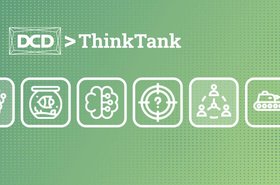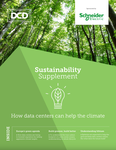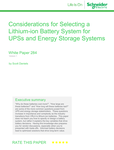Within data centers there are few assets more critical to continuity than the uninterruptible power supply (UPS). According to IHS Markits, the UPS market is expected to surpass over €8 billionby 2023, driven largely by the surge in edge computing and data center growth.
Speaking at DatacenterDynamics Europe late last year, CBRE’s Penny Madsen stated that 2021 would see an unprecedented 400MW of new space supplied across the Frankfurt, London, Amsterdam and Paris (FLAP) region and behind this quickly accelerating market is a considerable focus on investment in resilient power infrastructure. Now as demand for digital transformation continues apace, it’s needless to say that the need for uninterruptible power in mission-critical applications shows no sign of slowing.
Prevention is key to reducing downtime
In recent years the topic of data centers and sustainability has shed much light on our industry, particularly where concerns around the sectors energy usage and carbon impact has been concerned.
Yet amid efforts to develop resource-efficient facilities and drive the adoption of renewables, power grids have come under increasing amounts of pressure, largely due to three major factors. Firstly utility transmission grids have experienced few major upgrades; secondly, the exploration of new and renewable energy sources hav made the challenge of maintaining stable energy delivery more complex; and thirdly, extreme weather issues are becoming increasingly more common in the face of climate change.
Many data center operators will know that prevention is often the best form of cure, especially when it comes to downtime. So to mitigate the impact of any combination of these factors - which, despite best efforts, are almost entirely out of ones control - it is crucial to remember that in most cases, a range of UPS and generators can provide a simple solution to prevent downtime.
Outages are on the increase
According to the Uptime Institute’s 2020 Annual Report, one third of survey participants admitted to experiencing a major outage in the last 12 months, with a further one in six claiming it had cost them more than $1m (€830). Nonetheless, greater power security equates to less downtime and better business continuity, which remains a must-have for today’s data center operators.
Any power interruption of more than 20 milliseconds can cause IT systems to crash temporarily and in traditional data center environments, a power interruption of 60 seconds or more can result in a recovery period of hours or days to restart the applications that have been affected.
In essence, a UPS runtime should only need to carry a critical load until a point when the generators start, and where it can be transferred (typically within 10-20 seconds). However, dependent on the needs of the end user, the timings may differ greatly. For example, hyperscale data centers may require 2-5 minutes of battery runtime, whereas in the financial industry, a customer may ask for up to 10-15 minutes of battery span. Now with rack densities quickly increasing, some for instance within high performance computing (HPC) systems can reach between 30-100 kW per rack, both the IT and cooling systems need to be protected backed up by UPS power, as well as a generator.
Decarbonization and resiliency
While a generator can provide a better solution for long-term backup, there are a number of sustainability arguments stating the need to replace diesel generation in data centers with more sustainable or ‘green’ solutions. Comparatively, while a UPS can effectively hold onto maximum power availability for only a matter of minutes, it still remains the most energy efficient means of avoiding downtime where power is concerned. Some solutions even offer up to 99 percent uptime with 99 percent efficiency in certain operating modes.
Obviously, the more battery runtime you incorporate into your design, then usually the higher the capital and annual maintenance costs - especially if you are opting for a 2N data center design to create a fully redundant system.
For a customer this means that while one UPS supports the critical load, another fully redundant system is installed as a backup, silently watching in wait. However, while this offers a highly reliable design, it also comes at a high cost; The more redundant you make the design, the greater the reliability and availability. Yet, the greater the redundancy, the greater the operating costs and the lower the level of efficiency.
Whatever your choice, a UPS is arguably the most important component in any data center, so the system must be properly designed to deliver a balance between capital costs and the availability of resilient, efficient electrical power. So how can one achieve this?
Mission-critical considerations
- Design for Reliability and Availability
Most operators can achieve their desired level of reliability with an N+1 design configuration. Further, using a scalable modular UPS can also help to rightsize the system and scale as power requirements grow. - Determine your runtime
Theoretically, you only need enough runtime to carry the load until the generators start and the load is transferred. However, battery runtimes will vary depending on the end-user risk tolerance and the resiliency of the IT applications. Here it’s essential to work with your customer to design and specify a solution that meets their risk criteria and safeguards critical data. - Choose adaptable technology
VRLA batteries have been commonplace in data centers UPS for decades. However, in recent years, lithium ion (li-ion) batteries have become a key choice for operators, offering many benefits over the traditional VRLA systems. Most li-ion UPS will lower your Total Cost of Operations (TCO) by 30%-50%, and due to a lifecycle that is 2-3 times that of traditional VRLA cells, they offer greater energy densities and better return on investment (ROI).
Protecting against unexpected outages remains one of the top priorities for data center operators. Yet moving forward, we must ask ourselves if enough has been done to deliver the required level of resiliency, while driving, sustainable, energy efficient operations?
To learn more about optimizing the design and performance of UPS systems, download Schneider Electric White Paper “Cost, Speed, and Reliability Tradeoffs between N+1 UPS Configurations”.





